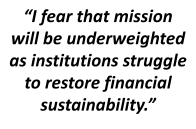What is the University's Purpose?
The report provides useful insights on higher education’s business model and how to fix it, but institutional purposes are not addressed explicitly. This blog describes the problem and introduces some emergent practical concepts and tools for balancing “mission”—used here as shorthand for the many elements of purpose—with markets, margins, and the other factors that drive decision-making.
A Clear and Present Danger
In broad terms, the mission of most colleges and universities is to educate students and to create, preserve and transmit knowledge, perspective and culture.
 Enshrined in countless mission and vision statements, these goals are intended to guide internal behavior as well as convey a sense of high-minded institutional purpose to external stakeholders. Schools differ in their definitions of “education” and the amount of emphasis placed on knowledge creation, but virtually all public and non-profit private institutions pursue these objectives in one way or another. (Even the so-called “teaching institutions” create knowledge by synthesizing content and instructional methodologies to meet their students’ needs – e.g., as in Boyer’s “scholarships of integration, application, and teaching and learning.”) Unfortunately, several problems complicate the pursuit of mission attainment.
Enshrined in countless mission and vision statements, these goals are intended to guide internal behavior as well as convey a sense of high-minded institutional purpose to external stakeholders. Schools differ in their definitions of “education” and the amount of emphasis placed on knowledge creation, but virtually all public and non-profit private institutions pursue these objectives in one way or another. (Even the so-called “teaching institutions” create knowledge by synthesizing content and instructional methodologies to meet their students’ needs – e.g., as in Boyer’s “scholarships of integration, application, and teaching and learning.”) Unfortunately, several problems complicate the pursuit of mission attainment.
First is the belief, prevalent among conservative political and business stakeholders since the Reagan era, that markets should be the ultimate arbiter of what’s important. Markets, it is said, will direct academic resources toward areas of student demand and, through competition, will contain costs by promoting efficiency. This paradigm essentially defines mission as serving the market—which, not incidentally, is what for-profit business firms are expected to do. (See Blog 3 in this series.) Chapter 2 of my Honoring the Trust summarizes the many reasons why markets should not be allowed to dominate the behavior of colleges and universities, but academics tend to be suspicious for one simple reason: markets conflate mission with money and challenge the intrinsic values associated with education and knowledge creation.
The second problem is bridging the gap between the broad statements of principal typically contained in mission statements and the practicalities of decision-making in particular situations. Yet, provosts, deans and faculty must think hard about the particulars of mission if they are to give it proper weight when besieged by urgent problems of demand, revenue, cost, and financial sustainability.
Attention to mission becomes all the more important when the scope of the needed changes is as large as it is today.

I fear that mission will be underweighted as institutions struggle to restore financial sustainability in the post-COVID-19 world. The problem can be seen already as schools rush to align their program portfolios more closely with the market, ferret out new market niches, and search aggressively for new ways to cut costs. I’m strongly in favor of such moves but believe that front-of-mind consideration of mission also should be integral to the decision-making process. It’s easy to imagine a post-COVID-19 world where schools successfully cater to students’ and employers’ immediate needs and preferences (first jobs and alleviation of current labor shortages, for example), but fail to educate the whole person, develop critical thinking about broad societal, political, and cultural issues, or provide opportunities for those who need them most. These are key elements of most institutions’ missions, but they are rarely significant drivers in the marketplace.
Mission erosion is all the more worrisome because today’s powerful market information systems and instructional economics models supply such extensive and compelling data. Extensive quantitative data can crowd out purely qualitative considerations, especially when urgent financial problems must be solved. The antidote is to balance the quantitative information about markets and margins with more focused mindfulness about mission.
Focused Mindfulness about Mission
I have been working with colleagues at Gray Associates on practical methods for assessing relative mission contributions in three critical areas: the size of degree programs, the availability of course offerings, and the choice of requests to approve in the annual budget process. The assessments involve subjective ratings or rankings, which may be informed by deconstructing the mission statement, evaluating past choice behavior, examining one’s own deep convictions, and consulting stakeholders. They can be conducted in an individual and/or a group setting. The important thing is that the judgments are made before analyzing the economic and market data. This exercise forces participants to be mindful about how the institution’s mission applies to the decision in question.
The graphics below demonstrate the value of even simple assessments of mission contribution to decisions about program sizing and curricular efficiency improvement.
Strong contributions appear as dark bubbles in the program chart and on the right-hand side of the course matrix. It’s easy to see how mission contribution tempers the effects of market and margin. Without these assessments the evidence would point to shrinking programs in the lower left-hand quadrant of the bubble chart, but this would not be a good move.
Likewise, relying on margin alone as the criterion for efficiency improvement would eliminate course offerings that are important for student success, the department’s academic discipline, or for other reasons. These are early days in the assessment of mission contribution, but my colleagues and I would welcome the opportunity to work with institutions that wish to pursue the possibilities.
Published at Mon, 18 Jan 2021 13:30:00 +0000
Article source: https://www.grayassociates.com/blog/looking-ahead-to-2021-and-beyond-whats-on-your-radar-0